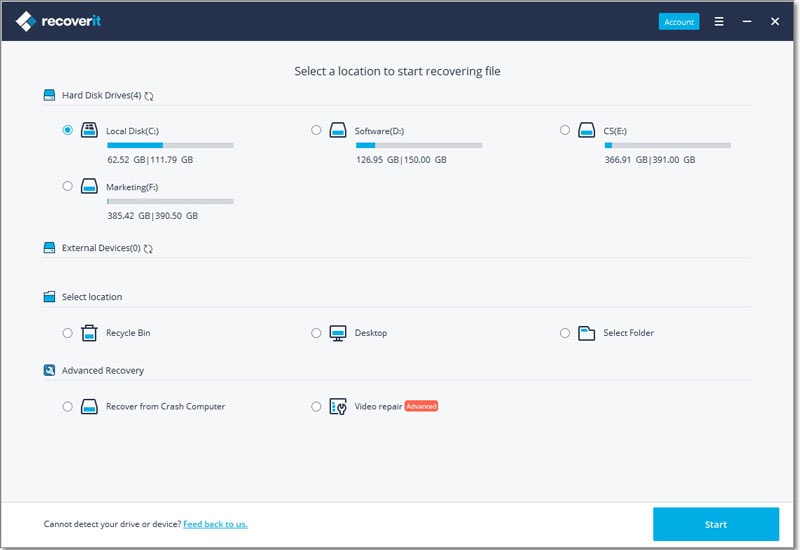Contents
- 1.1 Best Windows Recovery
- 1.2 Windows Recovery Tools
- 1.3 Windows 10 Recovery Tools
- 1.4 Windows Recovery Freeware
- 1.5 Stellar Phoenix Alternative
- 1.6 Remo Recover Alternative
- 2. Recover Files from Windows
- 2.1 Recover Deleted Files
- 2.2 Recover Permanently Deleted Files
- 2.3 Restore Deleted Files
- 2.4 Recover Files from Recycle Bin
- 2.5 Recover Folder
- 2.6 Recover Mail
- 2.7 Recover Document
- 2.8 Recover Photo
- 2.9 Recover Partition
- 2.10 Recover Password
- 3. Windows Recovery Solutions
- 3.1 Windows Backup Recovery
- 3.2 Windows Restore
- 3.3 Windows System Recovery
- 3.4 Windows Error Recovery
- 3.5 Windows Recovery Disk
- 3.6 Windows Recovery Disc
- 3.7 Windows USB Recovery
- 3.8 Windows Recovery Mode
- 3.9 Windows Unexpected Shutdown
Backing up Windows is a great way to prevent your computer from losing data. If you don't have the habit of making backup on a regular basis, you will have the possibilities of encounter data loss due to various reasons like virus, power failure, system crash and more. What to do if you were in such a situation? Is it possible to recover the data you lost? Below is an effective solution to Windows restore. Read on.
Part 1. The Best Windows Restoring Tool
iSkysoft Data Recovery helps you in recovering any type of data within just few clicks. It has many amazing features which could not be found in other software's.

- Different recovery modes for data loss: Wizard Recovery Mode, Lost File Recovery, Partition Recovery, Raw File Recovery and Resume Recovery
- Data loss due to other issues such as FAT32, FAT16, NTFS and exFAT
- Supports all kinds of devices, USB drives, external hard drives, memory cards, mobile phones, camcorder, memory sticks, floppy disks, zip drive, Pen drive and other storage media
- Retrieves any type of file such as image, video, audio, document, archive and email
- Preview Browse lost files with specific name after scan
- Read-only process and does not modify anything on your device
- User-friendly interface
- Compatible with Windows 10/8.1/8/7/8/Vista/XP/2000
Part 2. How to Restore Windows Disks
Out of the 4 different modes of data recovery options available for Windows, Wizard Mode is recommended for retrieval of any kind of data. But for recovery of any data from windows disk you could choose "Standard Mode" which is simple and easy to use.
Step 1. Select Recovery Module
After installing Recoverit (IS) on your Windows computer, it will automatically open the Wizard Mode. But you could switch to "Standard Mode".
Now select the file types. It helps you to find any lost, deleted, resized or damaged partition.
Step 2. Select a Physical Drive to Scan
You need to select the physical drive and click "Next" to start scanning the target drive. If you want to get better result, you can turn on Enable Deep Scan feature.
Step 3. Restore the Data You Need
When the scanning process gets over, the lost files will be displayed on your windows. You need to mark the files you want to recover and then click "Recover" button to save then to your Windows.
Tips to remember while recovering lost data from Windows disk:
- You could also use the "Wizard Mode" in iSkysoft Data Recovery. You just need to answer 2 simple questions to recover any specific or lost data from Windows disk. After answering the questions, the recovery process will start automatically.
- We know that all the files which are stored in you disk are very important to you. In case of deletion or system crash you don’t need to worry about losing your precious data permanently. Even though Windows may not be able to detect the file, the data will be surely present in your disk.
- Windows Recycle bin is the first place where you should be looking for your deleted files. To restore files from the recycle bin just right-click on the file and select restore from the menu.
- It is necessary to recover the deleted files from the hard disk immediately as Windows may overwrite with new files and your data will be lost forever.
- Remember to install the Data recovery software as a precautionary action because installing a file recovery program is also like writing over the disk.








